
SS 人種・移住本部
Rasse- und Siedlungshauptamt der SS, RuSHA
| The SS Race and
Settlement Main Office (Rasse- und Siedlungshauptamt der SS, RuSHA) was
the organization responsible for "safeguarding the racial 'purity' of
the SS" within Nazi Germany.[1] One of its duties was to oversee the marriages of SS personnel in accordance with the racial policy of Nazi Germany. After Heinrich Himmler introduced the "marriage order" on December 31, 1931, the RuSHA would only issue a permit to marry once detailed background investigations into the racial fitness of both prospective parents had been completed and proved both of them to be of Aryan descent back to 1800.[2][3] |
SS人種・移住本部(Rasse- und
Siedlungshauptamt der SS,
RuSHA)は、ナチス・ドイツにおける「SSの人種的『純粋性』を保護する」責任を負う組織であった[1]。 その任務の1つは、ナチスドイツの人種政策に従ってSS隊員の結婚を監督することであった。1931年12月31日にハインリッヒ・ヒムラーが「結婚命令」を導入した後、 RuSHAは結婚を希望する両親の人種的適性に関する詳細な背景調査が完了し、両者が1800 年に遡るアーリア人の子孫であることが証明されて初めて結婚許可を出すようになった[2][3]。 |
| Formation The RuSHA was founded in 1931 by Reichsführer-SS Heinrich Himmler and Richard Walther Darré, who later rose to the rank of SS-Obergruppenführer. In 1935, it was upgraded to an SS Main Office. Under its first director, Darré, it propagated the Nazi ideology of blood and soil. Darré was dismissed by Himmler in 1938 and was succeeded by SS-Gruppenführer Günther Pancke, SS-Gruppenführer Otto Hofmann in 1940, and then SS-Obergruppenführer Richard Hildebrandt in 1943.[4][5] The RuSHA was created in part to monitor Himmler's 1931 order that the marital decisions of unmarried SS men should be supervised by the Nazi state. SS men would thereafter have to apply for a marriage permit three months before getting married so that the parents of the fiancée could be investigated to ensure her racial purity. With time, the marriage laws became less strict.[6] Thereafter, in December 1935 Himmler ordered the RuSHA to establish the Lebensborn network of maternity homes, whose purpose was "to accommodate and look after racially and genetically valuable expectant mothers." The RuSHA increasingly focused on processing SS marriage applications, genealogy, "racial-biological" investigations and the social welfare services of SS members.[7] |
結成の経緯 1931年、ハインリッヒ・ヒムラー親衛隊大将とリヒャルト・ワルター・ダレ(後に親衛隊上級大将に昇進)によって設立された。1935年には、SS本部 に昇格した。初代所長ダレの下で、ナチスの「血と土(Blut und Boden)」のイデオロギーを広めた。ダレは1938年にヒムラーによって解任され、その後1940年にSS親衛隊長のギュンター・パンクェ、SS親衛 隊長のオットー・ホフマン、そして1943年にSS親衛隊長のリチャード・ヒルデブラントが後を継いだ[4][5]。 RuSHAは、未婚のSS隊員の結婚の決定をナチス国家によって監督されるべきという1931年のヒムラーの命令を一部監視するために設立された。その 後、SS隊員は結婚の3ヶ月前に結婚許可証を申請し、婚約者の両親を調査して人種的純潔性を確認することができるようになった。その後、1935年12月にヒムラーはRuSHAに「人種的・遺伝的に価値のある妊産婦を収容・保護す る」ことを目的とした産院ネットワークであるレーベンスボルン=Lebensbornを 設立するよう命じた[6]。RuSHAはますますSSの結婚申請の処理、系図、「人種・生物学的」調査、SSメンバーの社会福祉サービスに重点を置くよう になった[7]。 |
| In 1935 the RuSHA consisted of
seven departments (German: Ämter or Amtsgruppen): Amt Organisation und Verwaltungsamt (Organisation and Administration) Amt Rassenamt (Race) Amt Schulungsamt (Education) Amt Sippen und Heiratsamt (Family and Marriage) Amt Siedlungsamt (Settlement) Amt für Archiv und Zeitungswesen (Records and Press) Amt für Bevölkerungspolitik (Population Policy) In 1940 it was reorganized to create four main departments: Verwaltungsamt (Administration Office). Rassenamt (Racial Office), it selected future SS personnel and conducted racial selections. Heiratsamt (Marriage Office) it controlled the selection of suitable wives by SS men. Siedlungsamt (Settlement Office), it dealt with the settlement of discharged SS men, especially in the annexed eastern areas. The Race and Settlement Departments were further divided into the Hauptabteilungen (Main Branches). One of these managed welfare and pensions in cooperation with the SS-Hauptfürsorge- und Versorgungsamt (SS Main Welfare and Pension Department) at the Reich Ministry of the Interior. https://en.wikipedia.org/wiki/SS_Race_and_Settlement_Main_Office |
1935年当時、RuSHAは7つの部門(ドイツ語でÄmterまたは
Amtsgruppen)で構成されていた。 組織・管理部門(Amt Organisation und Verwaltungsamt) 人種部門(Amt Rassenamt) 教育部門(Amt Schulungsamt) 家族・相続部門(家族・結婚) 都市計画部門 (居住) 記録・報道部門 人口政策部門(Amt für Bevölkerungspolitik) 1940年には、以下の4つの主要部門に再編された。 Verwaltungsamt (管理局)。 Rassenamt(人種局):将来のSS隊員の選抜と人種選別を行う。 Heiratsamt (結婚局): SS隊員が適切な妻を選択することを管理する。 Siedlungsamt(入植局)は、退役したSS隊員の入植、特に併合された東部地区での入植を扱った。 人種局と居住局はさらにHauptabteilungen(主要支部)に分けられた。そのうちのひとつは、帝国内務省のSS-Hauptfürsorge - und Versorgungsamt(SS主要福祉・年金局)と協力して福祉と年金を管理するものであった。 |
| Reichsamt des Innern
(Imperial Office of the Interior) |
帝国内務局の歴史 |
| The Reichsamt des Innern
(Imperial Office of the Interior) was the Ministry of the Interior of
the German Empire. On the proposal of the Reichskanzler Otto von
Bismarck it was created on 24 December 1879 by an Imperial decree from
the Reich Chancellery. Like the other Imperial Offices it was directly
under the control of the Reichskanzler. The seat of the office was in
Berlin and it was managed by a Secretary of State, who from 1881 until
1916 also simultaneously held the office of Vizekanzler. The gazette
for the publication of official notices was run by the Office from
1880. Entitled the Zentralblatt für das Deutsche Reich (ZBl), it had
been published by the Reich Chancellery from 1873 until 1879. With the Law on the Provisional Imperial Government of 11 February 1919, the Imperial Office became the Reichsministerium des Innern (RMI) (Ministry of the Interior) which remained the German Ministry of the Interior during the Weimar Republic and Nazi Germany. From 1923 until 1945, the ministry published the government gazette, which was entitled the Reichsministerialblatt (RMBl). On 1 November 1934 it was united with the Prussian Ministry of the Interior as the Reichs- und Preußischen Ministerium des Innern (Imperial and Prussian Ministry of the Interior).[3] https://en.wikipedia.org/wiki/Federal_Ministry_of_the_Interior_and_Community |
帝国内務局(Reichsamt des
Innern)は、ドイツ帝国の内務省に相当する。1879年12月24日、オットー・フォン・ビスマルク帝
国総統の提案により、帝国総統府の勅令によって創設された。他の帝国官庁と同様、帝国主席の直接の支配下にあった。1881年から1916年までヴィゼカ
ンツラーを兼任していた国務長官が、ベルリンに本部を置いて運営した。1880年からは、公告を掲載する公報が事務局で運営されるようになった。1873
年から1879年まで帝国総統府が発行していたこの公報は、「Zentralblatt für das Deutsche Reich
(ZBl)」と題されたものであった。 1919年2月11日の臨時帝国政府に関する法律により、帝国府はReichsministerium des Innern(RMI)(内務省)となり、ワイマール共和国とナチスドイツの時代にも内務省として存続している。1923年から1945年まで、同省は 『Reichsministerialblatt』(RMBl)と呼ばれる官報を発行していた。1934年11月1日、プロイセン内務省と統合し、帝国・プロイセン内務省(Reichs- und Preußischen Ministerium des Innern)となった[3]。 https://www.deepl.com/ja/translator |
 |
・Richard
Walther Darré, 1895-1953. リヒャルト・ヴァ
ルター・ダレ. ・Günther Pancke, 1899-1973. ギュンター・パンケ. (警察官僚) ・Otto Hofmann, 1896-1982.オットー・ホフマン.空軍出身の軍人:親衛隊上級地区 「西方」(SS-Oberabschnitt "West")に人種専門家の将校として勤務した。1939年2月にRuSHAに戻り、人種審査部門の部長となる。さらに1939年8月から系図部門の部 長となる。 ・Richard Hildebrandt, 1897-1951. リヒャルト・ヒルデブ ラント. 軍人 |
| Racial policies By 1937 more than 300 SS men had been expelled from the SS for violating Nazi race laws (Rassenschande), although an order later stated that they could remain if they were already married and could satisfy racial criteria. In November 1940, Himmler reinstated all SS personnel expelled under the marriage laws, provided they met racial requirements of the Nazi Party. Following the invasion of the Soviet Union in 1941, the RuSHA worked in partnership with VOMI in the "germanization" of captured territory, monitoring of settler welfare, and the plantation of ethnic Germans in areas designated for settlement by the SS, particularly in occupied Ukraine. This involved in part, the resetting of Germans in the Nazi occupied Eastern territories and ejecting the native families from those lands. The RuSHA was also an advisory and executive office for all questions of racial selection. Racial examinations were performed by Rasse und Siedlungs (RUS) leaders or their racial examiners (Eignungsprüfer) in connection with: Cases where sexual intercourse had occurred between Eastern European POWs or workers and Germans Children born to Eastern European workers Classification of people of German descent Selection of enemy nationals, particularly Poles, for slave labour and Germanization Kidnapping of children suitable for Germanization Population transfers The persecution and liquidation of Jews The RuSHA also employed Josef Mengele for a short time from November 1940 to early 1941, in Department II of its Family Office, where he was responsible for "care of genetic health" and "genetic health tests".[8] He went on to become one of the team of doctors responsible for the selection of victims to be killed in the gas chambers and for performing deadly human experiments on prisoners at Auschwitz concentration camp.[9] |
人種政策 1937年までに300人以上のSS隊員がナチスの人種法(Rassenschande)違反で除名されたが、その後、既に結婚していて人種的基準を満た すことができれば残留できるとする命令が出された。1940年11月、ヒムラーは、ナチス党の人種的要件を満たすことを条件に、結婚法で追放されたすべて のSS隊員を復職させた。 1941年のソビエト連邦侵攻後、ルシャはVOMIと協力して、占領地の「ドイツ化」、入植者の福祉の監視、特に占領下のウクライナのSSによる入植指定 地域でのドイツ系民族の植林に取り組んだ。これは一部、ナチス占領下の東部地域でドイツ人をリセットし、その土地から先住民の家族を追い出すことを含んで いた。 RuSHAはまた、人種選別に関するあらゆる問題の諮問機関であり、執行機関でもあった。人種検査は、Rasse und Siedlungs(RUS)の指導者またはその人種検査官(Eignungsprüfer)によって、以下のような事柄に関して行われた。 東欧人捕虜または労働者とドイツ人との間で性交渉が行われたケース 東欧人労働者の間に生まれた子供 ドイツ系住民の分類 敵国人、特にポーランド人の奴隷労働およびドイツ化のための選別 ドイツ人化に適した子供の誘拐 人口移動 ユダヤ人の迫害と清算 ルシャはまた、1940年11月から1941年初頭までの短期間、ヨーゼフ・メンゲレを家族局の第二部に雇用し、彼は「遺伝子健康のケア」と「遺伝子健康 検査」を担当した[8]。 彼はその後、ガス室で殺される犠牲者の選別とアウシュビッツ強制収容所の囚人に対する致命的人体実験を担当した医師チームの一人になるのである[9]。 |
| "The RuSHA trial against the SS racial policies of genocide (officially, United States of America vs. Ulrich Greifelt, et al)../ In the RuSHA Trial, the 14 defendants were all officials of various SS organizations responsible for the implementation of the Nazi "pure race" programme: including RuSHA (Rasse- und Siedlungshauptamt, the "SS Race and Settlement Main Office"); the office of the Reich Commissioner for the Consolidation of German Nationhood (Reichskommissar für die Festigung des deutschen Volkstums, RKFDV; a post held by Heinrich Himmler); the Repatriation Office for Ethnic Germans (Volksdeutsche Mittelstelle, VoMi); and the Lebensborn society. The charges centered on their racial cleansing and resettlement activities." - RuSHA Trial. | 12の法廷があった「ニュルンベルク継続裁判」のひとつ「親衛隊人種ならびに移
住本部裁判(RuSHA Trial)(1947年10月20日 - 1948年3月10日)[Rasse-und
Siedlungshauptamt der SS, RuSHA ]」が第二次大戦後にあった。 SSの人種虐殺政策に対するRuSHA裁判(正式には、United States of America vs. Ulrich Greifelt, et al)...である。 / RuSHA裁判では、14人の被告が、RuSHA(Rasse- und Siedlungshauptamt、「SS人種・入植本部」)、ドイツ民族統合本部(Reichskommissar für die Festigung des deutschen Volkstums、RKFDV、ハインリヒ・ヒムラー)、ドイツ民族帰還事務所(Volksdeutsche Mittelstelle, VoMi)およびLebensborn協会といったナチの「純粋民族」計画実施に責任を持つ諸SS機関の職員全員であった。告発の中心は、彼らの人種浄化 と再定住の活動であった。 |
| Generalplan Ost
– the Nazi plan to ethnically-cleanse occupied Eastern Europe. Office of Racial Policy |
|
| https://en.wikipedia.org/wiki/SS_Race_and_Settlement_Main_Office | https://www.deepl.com/translator |
| Nazi Party Office of Racial
Policy The Office of Racial Policy was a department of the Nazi Party (NSDAP) that was founded for "unifying and supervising all indoctrination and propaganda work in the field of population and racial politics"[quote citation needed]. It began in 1933 as the Nazi Party Office for Enlightenment on Population Policy and Racial Welfare (German: Aufklärungsamt für Bevölkerungspolitik und Rassenpflege der NSDAP). By 1935, it had been renamed to the Nazi Party Office of Racial Policy (German: Rassenpolitisches Amt der NSDAP or RPA).[1] Dr. Walter Gross was tasked with creating the office, and remained its leader until his death at the end of the Second World War in April 1945.[2] |
ナ
チス党 人種政策局(注:SS-RuSHAとは業務が被っている) 人種政策局は、ナチス党(NSDAP)の部局で、「人口と人種政治の分野におけるすべての教化と宣伝活動を統一し監督する」ために設立された[要出典]部 局である。1933年にナチ党人口政策・人種福祉啓蒙局(独:Aufklärungsamt für Bevölkerungspolitik und Rassenpflege der NSDAP)として発足した。1935年までには、ナチ党人種政策局(ドイツ語:Rassenpolitisches Amt der NSDAPまたはRPA)に改名された[1]。 ヴァルター・グロース博士がこの事務所の創設に携わり、1945年4月の 第二次世界大戦の終結時に亡くなるまでその指導者であり続けた[2]。 |
| Purpose The main role of the RPA was to oversee the production and maintenance of propaganda regarding the ethnic consciousness of the Nordic Aryan master race.[3] This was termed "enlightenment" rather than "propaganda" by the Nazi authorities, because it was "not a call for immediate action but a long-term change in attitude".[4] Dr. Gross did not want people thinking of themselves as individuals but rather as "single links in the great chain of life".[4] |
目的 RPAの主な役割は、北欧アーリア人の主人種という民族意識に関するプロパガンダの制作と維持を監督することであった[3]。 これは「すぐに行動を求めるのではなく、長期的に態度を変える」ため、ナチ当局によって「プロパガンダ」ではなく「啓発」と呼ばれた[4]。 グロース博士は人々が自分を個人としてではなく、「生命の大きな鎖における単一のリンク」として考えてほしいと考えたのである[4]。 |
| Methods All Nazi Party racial information required the approval of Gross' office before publication. The department dealt with all measures concerning the field of population and racial policies in cooperation with other Nazi and SS agencies, such as the RKFDV. The RPA checked and passed all Nazi Party press releases on issues of race. It also provided input for drafting Nazi legislation regarding racial issue. The RPA produced Neues Volk, a monthly magazine aimed at a general readership rather than towards a specialist audience.[5][6] But while containing articles on topics such as travel tips, its central theme was the promotion of eugenics and ethnic consciousness.[7] Other publications created by the office included a ten-point plan to marriage. The guidelines, rather than focusing on love, stressed the ideal criteria for marriage in the Nazi state was the consideration of race and health. The pamphlet urged investigation of the ancestry of potential mates, and that the hereditarily fit should not remain single, concluding with the injunction to hope for many children.[8] Other works included "Can You Think Racially?" and "Peasantry between Yesterday and Today".[9] The RPA also created traveling exhibitions that presented the ideal Aryan type as unchanging in contrast to subhuman types.[10] In its first year, the office had published 14 pamphlets for racial education.[11] This led to the establishment of intensive training courses to create ethnic educators. More than a thousand Sturmabteilung personnel and recent medical school graduates were indoctrinated each year on Nazi racial topics until 1945.[9] |
方法 ナチス党のすべての人種情報は、出版前にグロースの事務所の承認を必要とした。この部門は、RKFDVのような他のナチスおよびSSの機関と協力して、人 口および人種政策の分野に関するすべての措置を取り扱った。RPAは人種問題に関するすべてのナチ党のプレスリリースをチェックし、通過させた。また、人 種問題に関するナチスの法律を起草するための情報も提供した。 RPAは専門家ではなく一般読者を対象とした月刊誌『Neues Volk』を制作したが[5][6]、旅行のヒントなどの記事を含みながら、その中心テーマは優生学と民族意識の促進であった[7]。 RPAが作成した他の出版物には結婚に関する10項目のプランが含まれていた。この指針は、恋愛に焦点を当てるのではなく、ナチス国家における結婚の理想 的な基準は、人種と健康への配慮であることを強調した。このパンフレットでは、結婚相手となりうる人物の家系を調査するよう促し、遺伝的に適した人物は独 身でいるべきでないとし、多くの子供を望むようにと結んでいる[8]。 その他にも『人種的に考えることができるか』や『昨日と今日の農民』などの著作がある[9]。 また、アーリア人の理想型が人間以下の型と対比して不変であることを示す巡回展を開催した[10]。 初年度には人種教育用のパンフレットを14冊出版し[11]、民族教育者を養成する集中研修コースが設置されるに至った。1945年まで毎年1000人以 上のシュトルマバテイルングの職員と医学部の新卒者がナチスの人種的なテーマについて教化された[9]。 |
【アーネンエアベ協会:Forschungsgemeinschaft Deutsches Ahnenerbe】
アーネンエルベとも。「ドイツ先史待代研究のための
ドイツ人遺産協会」の略称。リヒャルト・ヴァルター・ダレ(Richard
Walther Oskar Darré, 1895-1953)の農業省から資金を調達し、ハインリッ ヒ・ヒムラー(Heinrich
Luitpold Himmle, 1900-1945)[ハインリッヒ・ヒムラー]の援助のもと1935年に創立。ナチ党内でダレの勢力が衰退すると、ヒムラーは 同協会をSS
組織に統合し(1937)、強制収容所と同一の行政部門に組み入れた」(→「アーネンエアベ協会」)。
【レーベンスボルン:Lebensborn】
レーベンスボルン(Lebensborn) は、ナチ親衛隊(SS)の「人種・移住本部」が主導、運営したが「アーリア純血性」 の出生率向上と優 生学的な民族衛生(Racial hygiene)目的として設立した登録機関でありかつ福祉関連施設である(ナチに批判的な研究者は、レーベンスボルンを「子ども略奪機 関」と表現することが多い)。1935年の暮れに創設され、ナチス優生学政策の主要な機関と され た。レーベンスボルンが運営する施設では、ドイツでは8千人が出生し、ノルウェーでは8千から1万2千人が生まれたという(Simonsen 2006)。レーベンスボルンの設置は、それに先立つ1935年 9月15日に制定されたニュルンベルク法(「ド イツ人の血と名誉を守るための法律」(Gesetz zum Schutze des deutschen Blutes und der deutschen Ehre)と「帝国市民法」(Reichsbürgergesetz)の総称)における、アーリア条項の改定に基づき、「アーリア純血性」の確保と人口増 加が急務とされたからである。しばしば、「アーリア人種」の増加を主たる目的とす るレーベンスボルンは、ユダヤ人絶滅政策と(思想的に)対極になすものだと言われているが、両者のあいだに、例えば科学的知識(身体計測学など)の共有な どがあることをのぞいて、ほとんど連絡協力関係などはない。むしろ、優生学的政策として対極をなすのは精神障害者や精神障害児の人為的殺戮行為で精神科医 を中心とした医師たちが関わるアクツィオーンT4(Aktion T4)のほうであろうと考え られる。また「アーリア人種」の増加が自己目的とされたの で、優秀な子供への、軍隊による強制的な略取や、養子など「戦争の子供たち(War children)」などを 産んだ、人道的戦争犯罪のひとつとしても紹介されることがある。
レーベンスボルン(Lebensborn)が設置さ れたのは、ドイツ・オーストリアのほかに、ドイツ占領地(おもにナチの医師たちが考えた西方の「優秀人種」の居住地)など、最終的に34箇所におよぶ
| 設置された領土 |
箇所 |
摘要(出典:Lebensborn) |
| ドイツ |
10 |
|
| オーストリア |
3 |
|
| ポーランド |
6 |
General Government
– the occupied Polish territory and annexed lands of Poland): 6 (8 if
Stettin and Bad Polzin are included - Bydgoszcz, Kraków,
Helenówek pod Łodzią, Otwock, Smoszew koło Krotoszyna, Smoszewo; 8 if
you include Stettin and Połczyn-Zdrój (which became a part of Poland
only after the war) |
| ノルウェー |
9 |
|
| デンマーク |
2 |
|
| フランス |
1 |
(February
1944 – August 1944) – in Lamorlaye |
| ベルギー |
1 |
(March 1943
– September 1944) – in Wégimont, in the municipality of Soumagne |
| オランダ |
1 |
|
| ルクセンブルグ |
1 |
+++++++++++++++++++++++++++++++++++++++++++++++++++++++
SS 人種・移住本部年代記(Chronology of RuSHA)
+++++++++++++++++++++++++++++++++++++++++++++++++++++++
1931
1931年、ハインリッヒ・ヒムラー親衛隊大将とリ ヒャルト・ワルター・ダレ(後に親衛隊上級大将に昇進)によって設立
12月31日にハインリッヒ・ヒムラーが「結婚命
令」を導入する。
1932 1月よりリヒャルト・ワルター・ダレSS 人種・移住本部長に就任
1933-1934
(1933)7月結婚奨励法の可決。ベビー・ボーナ ス。中絶手術の実質的禁止。ナチの政権掌握の直前には、10万人の女性教師と3,000人の女性医師がいたが、最終的に解雇か辞任に追いやられる。 (1936年以降は禁止。大学は10%まで)。その理由は、「ナチズムにおけるあるべき女性観は「価値ある血統の血を増殖させる」ために多産する「控えめ で、従順で、献身的な主婦」が求められるというものであった(→「ナチスの女性政策」)。
(1934)ヒトラー「わが国家では、母親はもっと も重要な公民である」(Know about the role of women in Hitler's Reich, that of a child-bearers changed to workers in anti-aircraft service and emergency workers for the German army)。また、女性労働者は、マルクス主義の陰謀と、それを嫌悪した。
1935
9月15日に制定されたニュルンベルク法(「ド イツ人の血と名誉を守るための法律」(Gesetz zum Schutze des deutschen Blutes und der deutschen Ehre)と「帝国市民法」(Reichsbürgergesetz)の総称)における、アーリア条項の改定に基づき、「アーリア純血性」の確保と人口増 加が急務とされた
グントラム・プラム(Guntram Pflaum, 1903-??)が、ミュンヘンのSS(der I. SS-Standarte in München)より、Reichsstelle für Sippenforschung(国家保安本部)——アーリア人人種 認定担当の——にStabsführer(参謀長)として赴任。
1935年12月12日レーベンスボルン協会の発 足。ハインリッヒ・ヒムラーは同年「アーネンエアベ協会(アー ネンエルベ協会)」も設立している。レーベンスボルン協会の本部はミュンヘン(クレイとリープマン 1997:101)。しかし、その運用は、入所者とその家族による寄付で運用していた。また、建物は、元ユダヤ人の所有してた診療所やサナトリウムであっ た。また、その家具調度も、ユダヤ人からの略奪物だった(クレイとリープマン 1997:108-109)。
入所者の食事に関しても、自然食ならびに全粒粉好み のヒムラーの趣味が反映されたものであった。
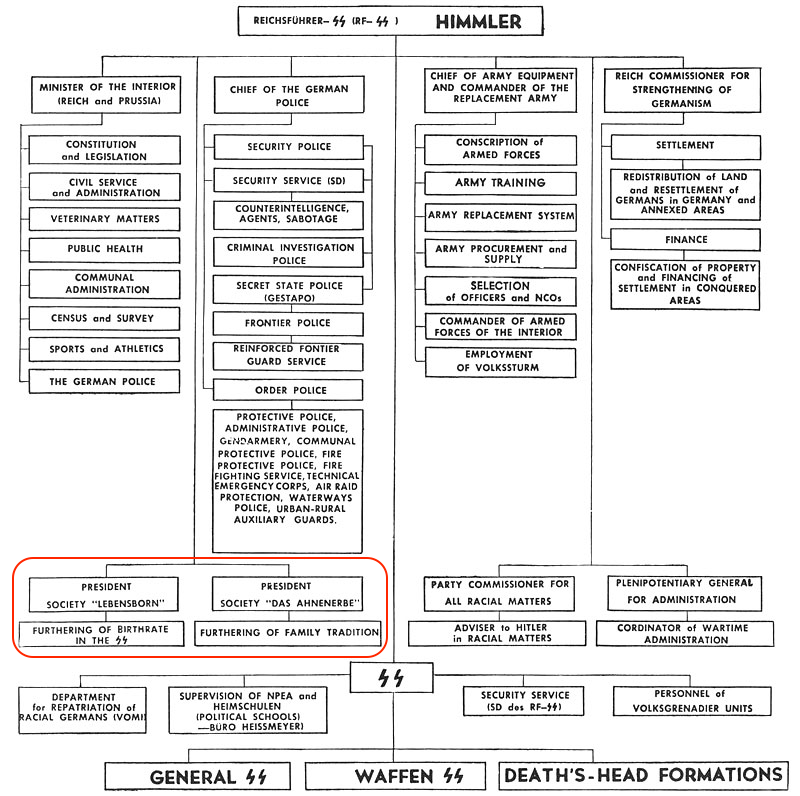
1936
1936年9月13日に、ヒムラーは、レーベンスボ ルン協会をSSの直接管理のもとにおく。
9月13日ハインリッヒ・ヒムラーはSSのメンバー に対して次のように書き送った。「レーベンスボルンe.V.」という組織は、SSの指導者たちに適格な子供の選定と養子縁組を提供するものである。組織 「Lebensborn e.V.」は私の個人的な指揮下にあり、SSの人種・定住中央局の一部であり、次の義務を負っている。 1)人種的、生物学的、遺伝学的に価値のある、多数の子供を持つ家庭を支援すること。 2)人種的、生物学的、遺伝学的に価値のある妊婦の斡旋と世話をすること。その妊婦とその子孫の家族をSSの人種・移住本部が徹底的に調査した結果、同 様に価値のある子供を生むと予想される妊婦を斡旋すること。 3)子供たちの世話 4)出産後の母親を大切にすること。 中央局のすべての指導者は、「Lebensborn e.V.」という組織の会員になることが名誉ある義務である。入会申し込みは、1936年9月23日以前に行わなければならない」。
最初のレーベンスボルン施設(通称「ハイム・ホーホ ラント(Hochland)=高地」)は1936年、ミュンヘンからほど近い小さな村、シュタインヘリングに開設された。


1938
1938年の終わりまでで、6ヶ所のレーベンスボル ン、通算で653人の入所母親があった。その6ヶ所とは、ブ レーメン郊外の「頂上」、ブラウンシュヴァイクのヴェルニゲローデ「ハルツ山地」、ベルリン北方クロースターハイデ「クアマルク」、ポンメルンのバート・ ポルツィン「ポンメルン」、そして、ウィーン近郊の「ヴィーナーヴァルト」——利用可能なベッド数は母親263床、赤ちゃん用は486床(クレイとリープ マン 1997:103)。
1938年11月9〜11日ドイツ全土でナチ党の指
令で都市のユダヤ人の居住区ゲットーが襲撃され、破壊されたユダヤ人排斥事件、いわゆる「水晶の夜(Kristallnacht)」が
おこる。
1939
ナチスは外国から子供を誘拐し始めた。ユーゴスラビ アと ポーランドを中心に、ロシア、ウクライナ、チェコスロバキア、ルーマニア、エストニア、ラトビア、ノルウェーなどから、リーベンスボルン計画のために子供 を誘拐した。このようなことを始めたのは、「(子供たちを)連れて行き、その環境から排除することが我々の義務だ...我々が自分たちのために使える 良い血を勝ち取り、我々の民族に居場所を与えるか、この血を破壊するかだ」と、ヒムラーが言ったと伝えられている。ナチスは、両親の目の前で子供を誘拐す る。誘拐された子供たちはいくつかのテストを受け、3つのグループに分類された。 1)ドイツ国民になるのが望ましいと思われる者。 2)受け入れられる者、そして 3)望まれない子供たちである。 望まれないと分類された子供たちは、強制収容所に連れて行かれて働かされるか、殺された。その他のグループの子供たちは、2歳から6歳までなら、プログラ ムの家庭に預けられ、一種の里子のような立場でその家庭で育てられた。6歳から12歳の子どもたちは、ドイツの寄宿学校に入れられた。学校では、子どもた ちに新しいドイツ名をつけ、ドイツの一員であることを誇りに思うように教えた。そして、子供たちに生みの親を忘れさせ、先祖の記録もすべて消した。ドイツ 化に抵抗する子供は殴られ、それでも反抗する子供は強制収容所に送られた。
1939
年1月24日には四カ年計画全権としてのゲーリングが、内務大臣ヴィルヘルム・フリックに対し「ドイツ国内からのユダヤ人国外移住を全力で促進
すべき」として、保安警察長官ラインハルト・ハイドリヒ指揮下に「ユダヤ人国外移住のためのライヒ中央本部」設置を命じた。ユダヤ人財産の
剥奪や
移動手段の制限はこうした「移住」を効率的に実行するための措置でもあった。しかしこのころから、ユダヤ人を受け入れてきた南米諸国など各国が難
色を示すようになり、第二次世界大戦勃発はさらにこうした移住を困難なものとした。
1941 ドイツ国 外では、1941年にノルウェーで最初のレーベンスボルンが開設される
1942 1月20日ヴァンゼー会議.この会議には、RuSHAのオットー・ホフマンも参加した。
1943 ベルギー: 1 (1943年3月 -
1944年9月) - Wégimont, Soumagneの自治体において
1944 フランス: 1 (1944年2月 - 1944年8月) - ラモルレーにて
1950 レーベンスボルンが強制的な繁殖計画であ ると報じた最初の記事は、1950年代にこのテーマで連載された ドイツの雑誌『レヴュー』に見られる。
2006 11月、ドイツのヴェルニゲローデという
町で、レーベンスボルンの子どもたち数人が、その神話を払拭し、自分の出自を調査することを目的とした公開ミーティングが開かれた。
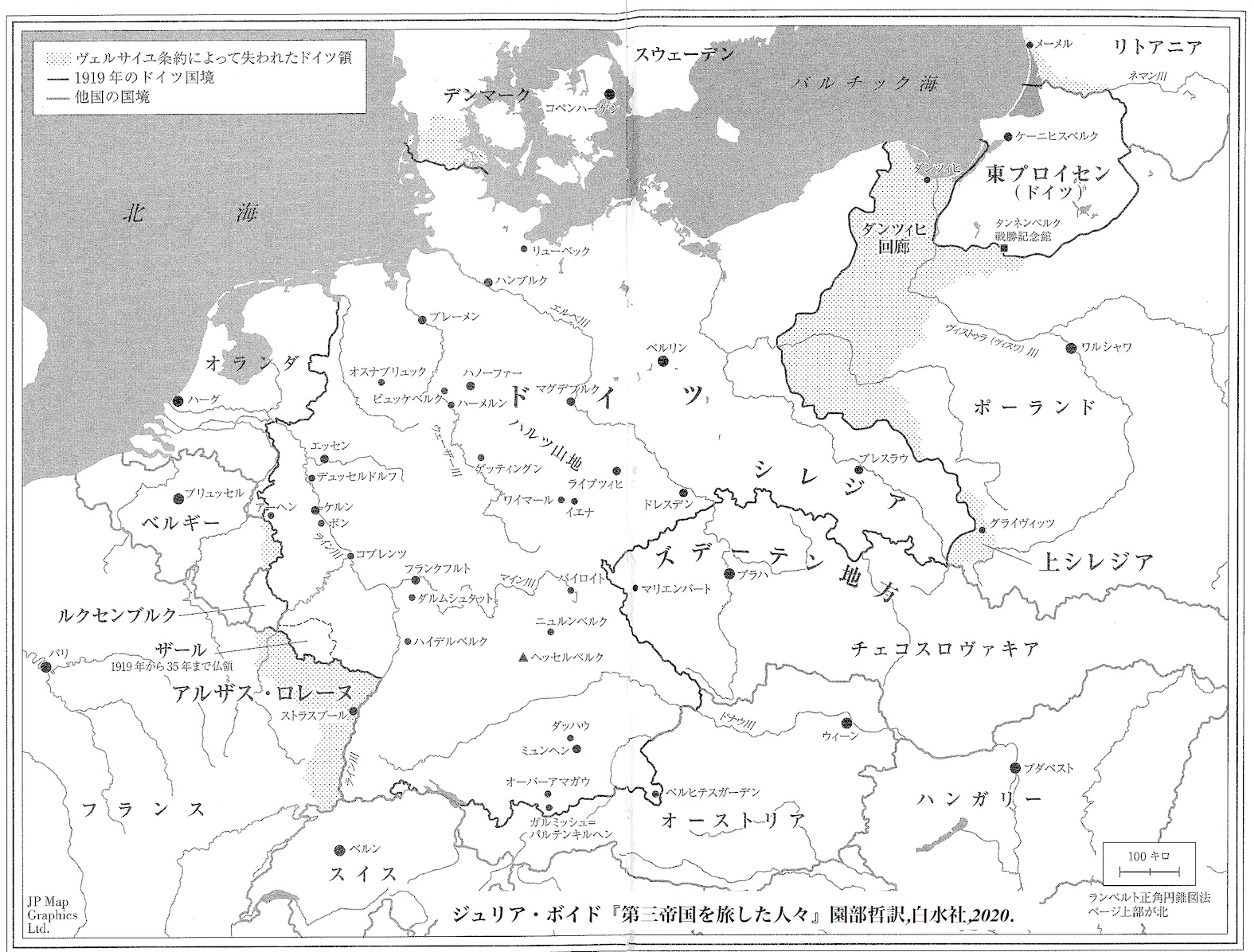
***
| General description |
Lebensborn e.V.
(literally: "Fount of Life") was an SS-initiated, state-supported,
registered association in Nazi Germany with the goal of raising the
birth rate of Aryan children of people classified as "racially pure"
and "healthy" based on Nazi racial hygiene and health ideology.
Lebensborn was established by Heinrich Himmler, and provided welfare to
its mostly unmarried mothers, encouraged anonymous births by unmarried
women at their maternity homes, and mediated adoption of these children
by likewise "racially pure" and "healthy" parents, particularly SS
members and their families. The Cross of Honour of the German Mother
was given to the women who bore the most Aryan children. Abortion was
legalised (and, more commonly, endorsed) by the Nazis for disabled and
non-Germanic children, but strictly punished otherwise. Initially set up in Germany in 1935, Lebensborn expanded into several occupied European countries with Germanic populations during the Second World War. It included the selection of "racially worthy" orphans for adoption and care for children born from Aryan women who had been in relationships with SS members. It originally excluded children born from unions between common soldiers and foreign women, because there was no proof of 'racial purity' on both sides. During the war, many children were kidnapped from their parents and judged by Aryan criteria for their suitability to be raised in Lebensborn homes, and fostering by German families. At the Nuremberg Trials, much direct evidence was found of the kidnapping of children by Nazi Germany, across Greater Germany during the period 1939–1945. |
レーベンスボルン(Lebensborn
e.V.)は、ナチスの人種衛生・健康思想に基づいて「人種的に純粋」で「健康」と分類された人々のアーリア人の子供の出生率を上げることを目的とした、
ナチスドイツのSS主導、国家支援による登録制協会であった。レーベンスボルンはハインリッヒ・ヒムラーによって設立され、主に未婚の母親に福祉を提供
し、未婚女性による産院での匿名出産を奨励し、同じく「人種的に純粋」で「健康な」親、特にSS隊員とその家族がこれらの子供を養子にする仲介を行った。
アーリア人の子供を最も多く産んだ女性には、ドイツ母十字勲章が贈られた。ナチスは、障害児や非ゲルマン系の子供のための中絶を合法化(より一般的には推
奨)したが、それ以外は厳しく罰した。 1935年にドイツで始まったレーベンスボーンは、第二次世界大戦中、ゲルマン民族を抱えるヨーロッパの占領国数カ国に拡大された。この制度では、「人種 的に価値のある」孤児を選んで養子に出したり、アーリア人女性でSS隊員と関係を持った者の子供を養育したりした。もともと、一般兵と外国人女性との間の 結婚で生まれた子どもは、双方が「人種的純潔」を証明するものがなかったため、除外されていたのである。戦時中、多くの子供たちが親から誘拐され、アーリ ア人の基準でレーベンスボルン家庭での養育に適しているかどうか判断され、ドイツ人家庭で養育された。 ニュルンベルク裁判では、1939年から1945年の間、大ドイツ全域でナチス・ドイツによる子供の誘拐があったという多くの直接的証拠が発見された。 |
| Background |
The Lebensborn e.V. (e.V. stands
for eingetragener Verein or registered association), meaning "fount of
life", was founded on 12 December 1935,[1] to counteract falling birth
rates in Germany, and to promote Nazi eugenics.[2] Located in Munich,
the organization was partly an office within the Schutzstaffel (SS)
responsible for certain family welfare programs, and partly a society
for Nazi leaders. On 13 September 1936, Heinrich Himmler wrote the following to members of the SS: The organisation "Lebensborn e.V." serves the SS leaders in the selection and adoption of qualified children. The organisation "Lebensborn e.V." is under my personal direction, is part of the Race and Settlement Central Bureau of the SS, and has the following obligations: Support racially, biologically and hereditarily valuable families with many children. Placement and care of racially, biologically and hereditarily valuable pregnant women, who, after thorough examination of their and the progenitor's families by the Race and Settlement Central Bureau of the SS, can be expected to produce equally valuable children. Care for the children. Care for the children's mothers. It is the honorable duty of all leaders of the central bureau to become members of the organisation "Lebensborn e.V.". The application for admission must be filed prior to 23 September 1936.[3] In 1939, membership stood at 8,000, of which 3,500 were SS leaders.[4] The Lebensborn office was part of SS Rasse und Siedlungshauptamt (SS Race and Settlement Main Office) until 1938, when it was transferred to Hauptamt Persönlicher Stab Reichsführer-SS (Personal Staff of the Reichführer-SS), i.e. directly overseen by Himmler. Leaders of Lebensborn e. V. were SS-Standartenführer Max Sollmann [de] and SS-Oberführer Dr. Gregor Ebner. |
生命の泉」を意味するLebensborn e.V. (e.V.
は eingetragener Verein または registered association)
は、ドイツの出生率低下に対抗し、ナチスの優生学を促進するために、1935年12月12日に設立された。ミュンヘンにあるこの団体は、ある種の家族福祉
プログラムを担当する親衛隊の事務所であり、ナチスの指導者のための社交場でもあった。 1936年9月13日、ハインリッヒ・ヒムラーはSSのメンバーに対して次のように書き送った。 「レーベンスボルンe.V.」という組織は、SSの指導者たちに適格な子供の選定と養子縁組を提供するものである。組織「Lebensborn e.V.」は私の個人的な指揮下にあり、SSの人種・定住中央局の一部であり、次の義務を負っている。 1)人種的、生物学的、遺伝学的に価値のある、多数の子供を持つ家庭を 支援すること。 2)人種的、生物学的、遺伝学的に価値のある妊婦の斡旋と世話をするこ と。その妊婦とその子孫の家族をSSの人種・定住中央局が徹底的に調査した結果、同 様に価値のある子供を生むと予想される妊婦を斡旋すること。 3)子供たちの世話 4)出産後の母親を大切にすること。 中央局のすべての指導者は、「Lebensborn e.V.」という組織の会員になることが名誉ある義務である。入会申し込みは、1936年9月23日以前に行わなければならない」。 1939年の会員数は8000人で、そのうち3500人がSSの指導者であった。レーベンスボルン事務所は1938年までSS Rasse und Siedlungshauptamt(SS民族・入植本部)の一部だったが、Hauptamt Persönlicher Stab Reichsführer-SS(帝国総統個人スタッフ)、すなわちヒムラーが直接監督する部門に移管された。レーベンスボルンe.V.のリーダーはSS 親衛隊のマックス・ゾルマン[de]とSS親衛隊長のグレゴー・エブナー博士であった。 |
| Implementation |
Initially the programme served
as a welfare institution for wives of SS officers; the organization ran
facilities – primarily maternity homes – where women could give birth
or get help with family matters. The programme also accepted unmarried
women who were either pregnant or had already given birth and were in
need of aid, provided that both the woman and the father of the child
were classified as "racially valuable". About 60% of the mothers were
unmarried. The program allowed them to give birth secretly away from
home without social stigma. In case the mothers wanted to give up the
children, the program also had orphanages and an adoption service.[5]
When dealing with non-SS members, parents and children were usually
examined by SS doctors before admission. The first Lebensborn home (known as "Heim Hochland") opened in 1936, in Steinhöring, a tiny village not far from Munich. The first home outside of Germany opened in Norway in 1941. Many of these facilities were established in confiscated houses and former nursing homes owned by Jews.[2] Leaders of the League of German Girls were instructed to recruit young women with the potential to become good breeding partners for SS officers.[6] While Lebensborn e. V. established facilities in several occupied countries, its activities were concentrated around Germany, Norway and occupied northeastern Europe, mainly Poland. The main focus in occupied Norway was aiding children born to Norwegian women and fathered by German soldiers. In northeastern Europe the organisation, in addition to services provided to SS members, engaged in the transfer of children, mostly orphans, to families in Germany. Lebensborn e. V. had or planned to have facilities in the following countries (some were merely field offices): Germany: 10 Austria: 3 Poland (General Government – the occupied Polish territory and annexed lands of Poland): 6 (8 if Stettin and Bad Polzin are included.)[7] Norway: 9 Denmark: 2 France: 1 (February 1944 – August 1944) – in Lamorlaye Belgium: 1 (March 1943 – September 1944) – in Wégimont, in the municipality of Soumagne Netherlands: 1 Luxembourg: 1 About 8,000 children were born in Lebensborn homes in Germany, and between 8,000 and 12,000 children in Norway. Elsewhere the total number of births was much lower.[8] For more information about Lebensborn in Norway, see war children. In Norway the Lebensborn organisation handled approximately 250 adoptions. In most of these cases the mothers had agreed to the adoption, but not all were informed that their children would be sent to Germany for adoption. The Norwegian government recovered only 170 of these children after the war. |
当初、このプログラムはSS将校の妻のための福祉施設として機能してい
た。この組織は、女性が出産したり家庭問題の援助を受けたりできる施設、主に産院を運営していた。また、妊娠中または出産後で援助を必要としている未婚の
女性も、女性と子供の父親の両方が「人種的に価値がある」と分類されれば、このプログラムに参加することができた。母親は約6割が未婚であった。この制度
により、彼女たちは社会的な烙印を押されることなく、家から離れてこっそり出産することができるようになった。また、母親が子供を手放したくなった時のた
めに、孤児院や養子縁組のサービスも用意されていた。非SS隊員を扱う場合、親と子どもは通常、入所前にSSの医師の診察を受けた。 最初のレーベンスボルン施設(通称「ハイム・ホッホランド」)は1936年、ミュンヘンからほど近い小さな村、シュタインヘリングに開設された。ドイツ国 外では、1941年にノルウェーで開設されたのが最初である。これらの施設の多くは、ユダヤ人が所有していた没収された家屋や元老人ホームを利用して設立 された。ドイツ少女同盟の指導者たちは、SS将校のよい交配相手となる可能性のある若い女性を勧誘するように指示された。 レーベンスボルンe.V.はいくつかの占領国に施設を設立したが、その活動はドイツ、ノルウェー、ポーランドを中心とする占領下の北東ヨーロッパ周辺に集 中していた。占領下のノルウェーでは、ドイツ兵を父に持つノルウェー人女性との間に生まれた子供の援助が主な活動内容であった。北東ヨーロッパでは、SS 隊員へのサービスに加えて、主に孤児である子供たちをドイツの家庭へ移送する業務も行っていた。 Lebensborn e. V.は以下の国に施設を持ち、また持つ予定であった(一部は単なるフィールドオフィスであった)。 ドイツ:10 オーストリア:3 ポーランド(一般政府-占領されたポーランド領とポーランドの併合地)。6(シュテッチン、バートポルツィンを含めると8)。 ノルウェー 9 デンマーク:2 フランス: 1 (1944年2月 - 1944年8月) - ラモルレーにて ベルギー: 1 (1943年3月 - 1944年9月) - Wégimont, Soumagneの自治体において オランダ 1 ルクセンブルク:1名 ドイツでは約8000人の子供が、ノルウェーでは8000人から1万2000人の子供がレーベンスボルン・ホームで生まれました。その他の地域では、総出 生数はもっと少なかった。ノルウェーのレーベンスボルンについて詳しくは、「戦争の子どもたち」を参照。 ノルウェーでは、レーベンスボルンの組織は約250件の養子縁組を扱った。そのほとんどは母親が養子縁組に同意していたが、全員が自分の子どもがドイツに 送られて養子になることを知らされていたわけではない。戦後、ノルウェー政府が回収したのは、これらの子どものうちわずか170人であった。 |
| Germanisation |
In 1939, the Nazis started to
kidnap children from foreign countries – mainly from Yugoslavia and
Poland, but also including Russia, Ukraine, Czechoslovakia, Romania,
Estonia, Latvia, and Norway– for the Lebensborn program. They started
to do this because "It is our duty to take [the children] with us to
remove them from their environment ... either we win over any good
blood that we can use for ourselves and give it a place in our people
or we destroy this blood," Himmler reportedly said. The Nazis would seize children in full view of the parents. The kidnapped children were administered several tests and were categorised into three groups: those considered desirable to be included into the German population, those who were acceptable, and the unwanted. The children classified as unwanted were taken to concentration camps to work or were killed. The children from the other groups, if between the ages of 2 and 6, were placed with families in the programme to be brought up by them in a kind of foster child status. Children of ages 6 to 12 were placed in German boarding schools. The schools assigned the children new German names and taught them to be proud to be part of Germany. They forced the children to forget their birth parents and erased any records of their ancestry. Those who resisted Germanisation were beaten and, if a child continued to rebel, he or she would be sent to a concentration camp. In the final stages of the war, the files of all children kidnapped for the programme were destroyed. As a result, researchers have found it nearly impossible to learn how many children were taken. The Polish government has claimed that 10,000 children were kidnapped, and less than 15% were returned to their biological parents. |
1939年、ナチスは外国から子供を誘拐し始めた。ユーゴスラビアと
ポーランドを中心に、ロシア、ウクライナ、チェコスロバキア、ルーマニア、エストニア、ラトビア、ノルウェーなどから、レーベンスボルン計画のために子供
を誘拐したのだ。このようなことを始めたのは、「(子供たちを)連れて行き、その環境から排除することが我々の義務だ...我々が自分たちのために使える
良い血を勝ち取り、我々の民族に居場所を与えるか、この血を破壊するかだ」と、ヒムラーが言ったと伝えられている。 ナチスは、両親の目の前で子供を誘拐する。誘拐された子供たちはいくつかのテストを受け、3つのグループに分類された。 1)ドイツ国民になるのが望ましいと思われる者。 2)受け入れられる者、そして 3)望まれない子供たちである。 望まれないと分類された子供たちは、強制収容所に連れて行かれて働かされるか、殺された。その他のグループの子供たちは、2歳から6歳までなら、プログラ ムの家庭に預けられ、一種の里子のような立場でその家庭で育てられた。6歳から12歳の子どもたちは、ドイツの寄宿学校に入れられた。学校では、子どもた ちに新しいドイツ名をつけ、ドイツの一員であることを誇りに思うように教えた。そして、子供たちに生みの親を忘れさせ、先祖の記録もすべて消した。ドイツ 化に抵抗する子供は殴られ、それでも反抗する子供は強制収容所に送られた。 戦争末期には、このプログラムのために誘拐されたすべての子供たちのファイルが破壊された。そのため、何人の子供が誘拐されたかを知ることは、研究者に とってほとんど不可能である。ポーランド政府は、1万人の子供が誘拐され、実の親に返されたのは15%以下であったと主張している。 |
| Post-war, Kidnapping charges |
After the war, the branch of the
Lebensborn organisation operating in north-eastern Europe was accused
of kidnapping children deemed "racially valuable" in order to resettle
them with German families. However, of approximately 10,000
foreign-born children located after the war in the American-controlled
area of Germany, in the trial of the leaders of the Lebensborn
organisation (United States of America v. Ulrich Greifelt, et al.), the
court found that 340 had been handled by Lebensborn e. V. The accused
were acquitted on charges of kidnapping. The court found ample evidence of an existing programme of the kidnapping or forced movement of children in north-eastern Europe, but concluded that these activities were carried out by individuals who were not members of Lebensborn. Exactly how many children were moved by Lebensborn or other organisations remains unknown due to the destruction of archives by SS members prior to fleeing the advancing Allied forces. From the trial's transcript:[13] The prosecution has failed to prove with the requisite certainty the participation of Lebensborn, and the defendants connected there with in the kidnapping programme conducted by the Nazis. While the evidence has disclosed that thousands upon thousands of children were unquestionably kidnapped by other agencies or organisations and brought into Germany, the evidence has further disclosed that only a small percentage of the total number ever found their way into Lebensborn. And of this number only in isolated instances did Lebensborn take children who had a living parent. The majority of those children in any way connected with Lebensborn were orphans of ethnic Germans. Upon the evidence submitted, the defendant Sollmann is found not guilty on counts one and two of the indictment. |
戦後、北東ヨーロッパで活動していたレーベンスボルン組織は、「人種的
に価値のある」子どもを誘拐し、ドイツ人家庭に再定住させたとして告発された。しかし、戦後、アメリカ支配下のドイツで見つかった約1万人の外国生まれの
子どものうち、レーベンスボル組織の指導者の裁判(United States of America v. Ulrich Greifelt et
al.)では、340人がLebensborn e. Vに扱われていたことが判明し、被告人は誘拐罪で無罪となりました。 裁判所は、北東ヨーロッパで子どもの誘拐や強制移動のプログラムが存在していたことを示す十分な証拠を見つけたが、これらの活動はレーベンスボルンのメン バーではない個人によって行われていたと結論づけた。レーベンスボルや他の組織によって移動させられた子どもの数は、前進する連合国軍から逃れる前にSS メンバーによって資料が破壊されたため、正確にはまだ不明である。 裁判記録から 検察側は、ナチスが行った誘拐計画へのレーベンスボルンおよびそれに関係する被告人の参加を必要な確実性をもって証明することができなかった。証拠は、何 千何万もの子供たちが、疑いなく、他の機関や組織によって誘拐され、ドイツに連れてこられたことを明らかにしているが、証拠はさらに、総数のほんの数パー セントしか、レーベンスボルに流れ込んだことがないことを明らかにしている。そして、この数のうち、レーベンスボルが生みの親のいる子どもを引き取ったの は、孤立した事例だけであった。レーベンスボルンに何らかの形で関係している子どもの大半は、ドイツ民族の孤児であった。提出された証拠により、被告ソル マンは、起訴状の第1および第2項について無罪とされる。 |
| Treatment of children |
After Germany's surrender, the
press reported on the unusually good weight and health of the "super
babies". They spent time outdoors in sunlight and received two baths a
day. Everything that came into contact with the babies was disinfected
first. Nurses ensured that the children ate everything given to
them.[14] Until the last days of the war, the mothers and the children
at maternity homes got the best treatment available, including food,
although others in the area were starving. Once the war ended, local
communities often took revenge on the women, beating them, cutting off
their hair, and running them out of the community. Many Lebensborn
children were born to unwed mothers. After the war, Lebensborn
survivors were often subjected to ostracization. |
ドイツが降伏した後、マスコミは「スーパーベビー」たちの体重や健康状
態が異常に良いことを報道した。彼らは屋外で日光浴をし、1日に2回お風呂に入る。赤ちゃんに触れるものはすべて消毒された。看護婦は、子供たちが与えら
れたものをすべて食べるようにした。戦争末期まで、産院の母子には食事も含めて最高の待遇が与えられていたが、他の地域は飢えていた。戦争が終わると、地
域社会はしばしば彼女たちに復讐し、殴り、髪を切り、地域社会から追い出してしまった。レーベンスボルンの子どもたちの多くは、未婚の母から生まれた。戦
後、レーベンスボルンの生存者たちは、しばしば排斥の対象となった。 |
| False assumptions |
Himmler's effort to secure a
"racially pure" Greater Germany, sloppy journalism on the subject, as
well as Nazi ideology retained by some, led to persistent false
assumptions about the programme. The main misconception was that the
programme involved coercive breeding. The first stories reporting that
Lebensborn was a coercive breeding programme can be found in the German
magazine Revue, which ran a series on the subject in the 1950s. The programme did intend to promote the growth of Aryan populations, through encouraging relationships between German soldiers and Nordic women in occupied countries. Access to Lebensborn was restricted in accordance with the Nordicist eugenic and racial policies of Nazism, which could be referred to as supervised selective breeding. Recently discovered records and ongoing testimony of Lebensborn children – and some of their parents – shows that some SS men did sire children in Himmler's Lebensborn program. This was widely rumored within Germany during the period of the programme. |
人種的に純粋な」大ドイツを確保しようとするヒムラーの努力、この問題
に関する杜撰なジャーナリズム、そして一部に残るナチスのイデオロギーが、この計画に関する誤った認識を根強くさせたのである。主な誤解は、この計画が強
制的な交配を伴うものであるというものであった。レーベンスボルンが強制的な繁殖計画であると報じた最初の記事は、1950年代にこのテーマで連載された
ドイツの雑誌『レヴュー』に見られる。 この計画は、ドイツ兵と占領国の北欧女性との関係を促進することによって、アーリア人の人口増加を意図したものであった。ナチズムの北欧優生主義・人種政 策に基づき、レーベンスボルンへのアクセスは制限された。それは、監督下の選択的交配とも言うことができる。最近発見された記録やレーベンスボルンの子供 たち、そしてその両親の証言によると、ヒムラーのレーベンスボルン計画で子供を産んだSS隊員もいたことが明らかになっている。このことは、プログラムの 期間中、ドイツ国内で広く噂されていた。 |
| Self-help groups and aftermath |
Help, recognition, and justice
for Lebensborn survivors have been varied. In Norway, children born to Norwegian mothers by German fathers were allegedly often bullied, raped, abused, and persecuted by the government after the war, and placed in mental institutions. The Norwegian government attempted to deport Lebensborn children to Germany, Brazil, and Australia but did not succeed. A group of Lebensborn children sought compensation from the Norwegian government, who they saw as being complicit in their mistreatment. In 2008, their case before the European Court of Human Rights was dismissed as the events had happened too long ago, but they were each offered an £8,000 payment from the Norwegian government.[17] In November 2006, in the German town of Wernigerode, an open meeting took place among several Lebensborn children, with the intention of dispelling myths and encouraging those affected to investigate their origins.[18][19] Sweden took in several hundred Lebensborn children from Norway after the war. A famous survivor is Anni-Frid "Frida" Lyngstad, a member of the music group ABBA. Her father was a sergeant in the Wehrmacht, and her mother was Norwegian; to escape persecution after the war, her grandmother took Lyngstad to Sweden.[20] Other countries that had Lebensborn clinics include France, Belgium, the Netherlands, Poland, and Luxembourg. General documents on Lebensborn activities are administered by International Tracing Service and by German Federal Archives.[21] The association Verein kriegskind.de is among those that published search efforts (Suchbitten) to identify Lebensborn children.[22] Hauptamt Volksdeutsche Mittelstelle Racial policy of Nazi Germany SS Race and Settlement Main Office(このページのメインソース) |
レーベンスボルン生存者に対する援助、認識、正義は様々である。 ノルウェーでは、ドイツ人の父とノルウェー人の母の間に生まれた子どもたちは、戦後、政府によってしばしばいじめられ、レイプされ、虐待され、迫害され、 精神病院に収容されたと言われています。ノルウェー政府は、レーベンスボルンの子どもたちをドイツ、ブラジル、オーストラリアに強制送還しようとしたが、 うまくいかなかった。レーベンスボルンの子どもたちのグループは、自分たちが虐待を受けたことに対して、ノルウェー政府に補償を求めた。2008年、欧州 人権裁判所への提訴は、事件が遠い過去のことであるとして却下されたが、ノルウェー政府からそれぞれ8,000ポンドの支払いを受けることになった。 2006年11月、ドイツのヴェルニゲローデという町で、レーベンスボルンの子どもたち数人が、その神話を払拭し、自分の出自を調査することを目的とした 公開ミーティングが開かれた。 スウェーデンは戦後、ノルウェーから数百人のレーベンスボルンの子どもたちを受け入れた。有名な生存者は、音楽グループABBAのメンバーであるアンニ・ フリード・「フリーダ」・リングスタッドです。父親はドイツ国防軍の軍曹、母親はノルウェー人で、戦後の迫害を逃れるため、祖母がリングスタをスウェーデ ンに連れて行った。 レーベンスボルン・クリニックがあった国は、他にフランス、ベルギー、オランダ、ポーランド、ルクセンブルグがある。 レーベンスボルン活動に関する一般的な資料は、国際追跡サービスおよびドイツ連邦公文書館で管理されている。Verein kriegskind.deは、レーベンスボーン児を特定するための探索活動(Suchbitten)を発表している団体である。 |
*
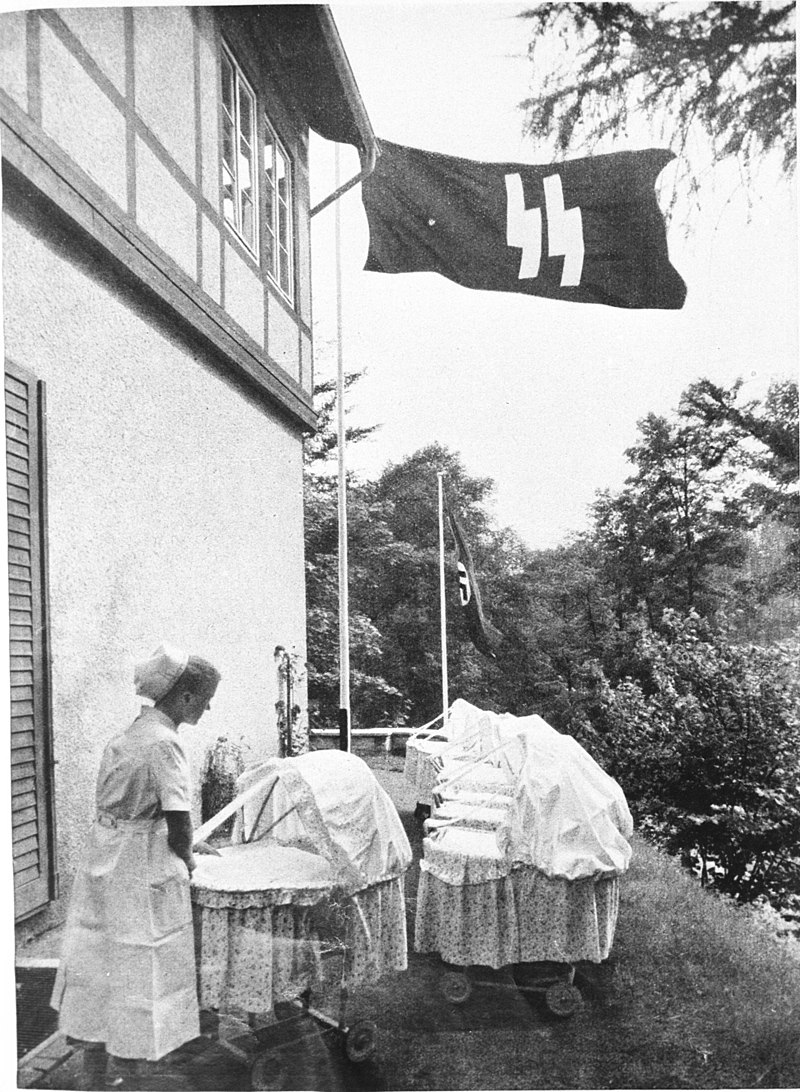 |
A Lebensborn birth house,
Bundesarchiv, Bild 146-1973-010-11 / CC-BY-SA 3.0 File:Bundesarchiv Bild 146-1973-010-11, Schwester in einem Lebensbornheim.jpg Created: 1943date QS:P571,+1943-00-00T00:00:00Z/9 |
 |
Christening of a Lebensborn
child, c. 1935–1936, Rhenish Hesse region, Bundesarchiv, Bild
146-1969-062A-58 / CC-BY-SA 3.0 File:Bundesarchiv Bild 146-1969-062A-58, "Verein Lebensborn", Taufe.jpg Created: circa 1936 date QS:P571,+1936-00-00T00:00:00Z/9,P1480,Q5727902/1944 |
 |
Kidnapping of Polish children
during the Nazi-German resettlement operation in Zamość county, Unknown
author - Józef Fajkowski: Wieś w ogniu. Eksterminacja wsi polskiej w
okresie okupacji hitlerowskiej. Warszawa: Ludowa Spółdzielnia
Wydawnicza, 1972. Kidnapping of Polish children during the Nazi-German
resettlement operation at Zamojszczyzna (1942-1943). |
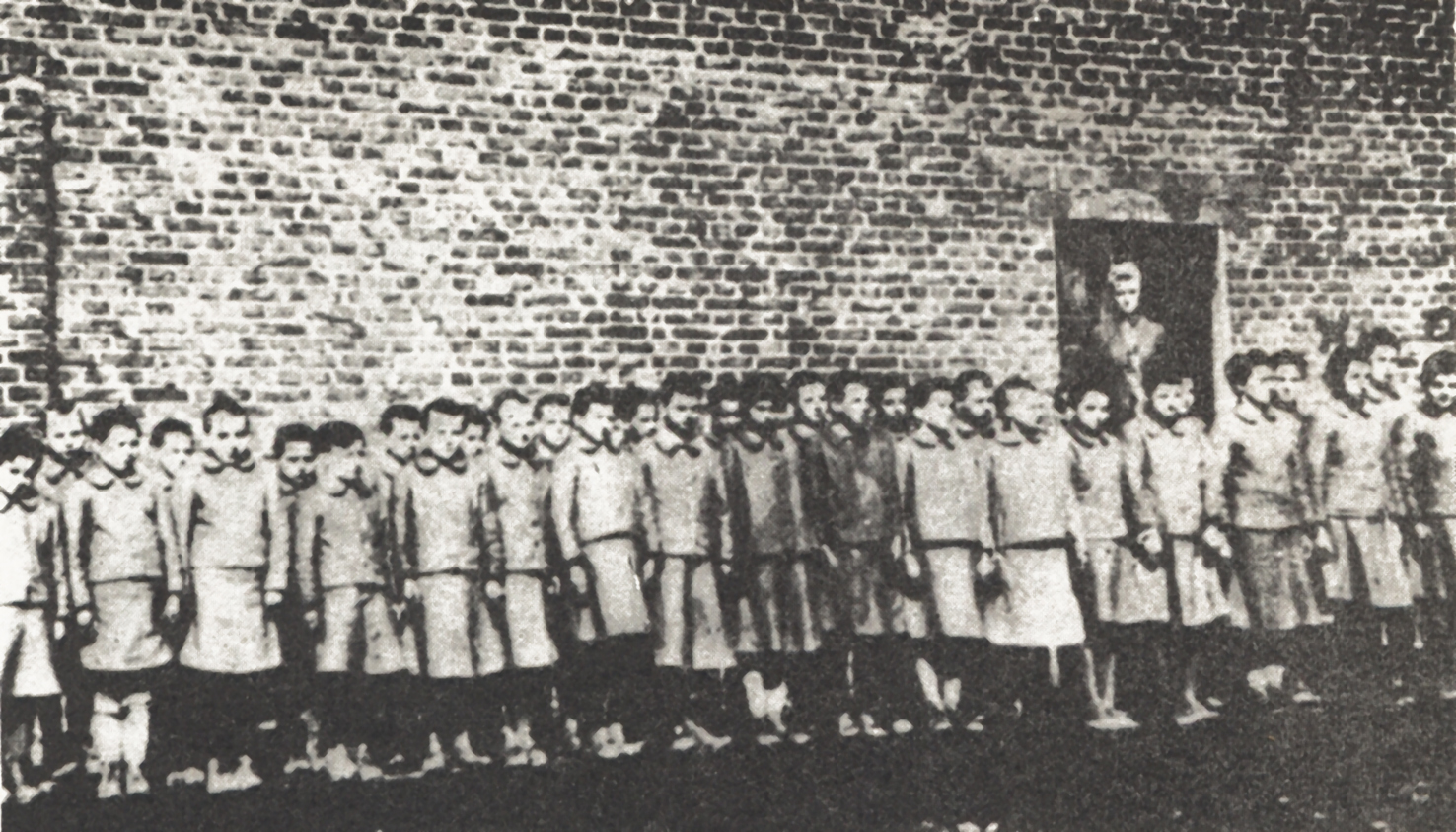 |
Polish children in Nazi-German
labour camp in Dzierżązna near Zgierz, Unknown author - Józef
Fajkowski: Wieś w ogniu. Eksterminacja wsi polskiej w okresie okupacji
hitlerowskiej. Warszawa: Ludowa Spółdzielnia Wydawnicza, 1972. Polish
girls in Nazi-German labor camp in Dzierżązna near Zgierz. Among the
child prisoners were Polish girls resettled from Zamojszczyzna
(1942-1943) |
 Max
Sollmann
(6. Juni 1904-1978), Kaufmann, SS-Standartenführer (1940) und Leiter
des
lebensborn e.V.. Im Rahmen der Nürnberger Prozesse im Prozess Rasse-
und Siedlungshauptamt der SS zu 2 jahren und 8 Monaten haft verurteilt. Max
Sollmann
(6. Juni 1904-1978), Kaufmann, SS-Standartenführer (1940) und Leiter
des
lebensborn e.V.. Im Rahmen der Nürnberger Prozesse im Prozess Rasse-
und Siedlungshauptamt der SS zu 2 jahren und 8 Monaten haft verurteilt. |
マックス・ソルマン(Max Sollmann;
1904年6月6日 バイロイト– 1978年5月27日ミュンヘン)は、ドイツの企業家、ナチ時代のSSリーダー、レーベンスボルン長官。 ソルマンはミュンヘンで学生時代を過ごした後、ビショッフ・グラフィック・アート・インスティテュートで学び、その後、美術工芸品会社で働くようになっ た。第一次世界大戦後、ソルマンは1920年から1921年にかけて、エップ自由騎士団とオーベルラント連邦軍に所属していた。ソルマンは、1921年に NSDAP(会員番号14,528)に加入した。1923年11月、ソルマンはヒトラーの突撃作戦に最年少で参加し、後にその功績で血盟勲章を授与され た。 1929年から1934年まで、ソルマンはコロンビアに滞在した。そこで彼は、いくつかのデパートのオーナーになった。その後、ドイツ帝国に戻った。 その間にNSDAPが禁止されたため、1937年に再入党した(会員番号35,362)。ソルマンは1937年にSS親衛隊の一員となり、SS親衛隊長 (隊員番号282,277)に昇進し、1940年にはSS親衛隊長になった。ソールマンはNSDAPの黄金の党章を持ち、NSDAPの銀と銅の功労賞も受 賞している。 第二次世界大戦勃発後、ソルマンは、ドイツ国家主義強化委員会のコンサルタント兼経済問題特別代表を務めた。1940年の春、親衛隊のハインリヒ・ヒム ラー総統は、ソルマンに多額の負債を抱えていたレーベンスボルン・イーヴの会計監査を依頼した。1940年4月11日、ヒムラーの命令で、ソルマンはグン トラム・プラム(Guntram Pflaum, 1903-??)の後任としてレーベンスボルンe.V.の長官となった。 1940年5月から1945年春の終戦まで、ソルマンはレーベンスボルンの専務取締役を務めた。 レーベンスボルンの医療責任者はグレガー・エブネルであった。1942年4月から、ソルマンはL部部長としてヒムラーの個人的なスタッフの一員となった。 1943年6月21日付の書簡で、ヒムラーはソルマンにプラハのハンス・フランクを訪ね、処刑されたチェコのレジスタンス戦士の子供の運命について話し 合うように指示した。人種的気質の悪い子供は子供のための特定の収容所に送られ、人種的気質の良い子供は保護観察に付されることになっていた。ヒムラー は、適切なケアと教育がなければ、子供は親の最も危険な復讐者になる恐れがあると表明していた-レーベンスボルンに、性格テストの後、養子または里子とし てドイツの家庭に分配される可能性があった。フランクとソルマンの会談は7月2日に行われた。7月7日付のヒムラー宛ての手紙の中で、ソルマンは、人種的 に受け入れ可能で、まだ就学年齢に達していない子供たちを、レーベンスボルンを通じてドイツ人家庭に斡旋することを告げた。 |
Guntram Pflaum,
Guntram Pflaum (* 13. April 1903 in Freystadt; † 1945 vermisst)[1] war
ein deutscher SS-Führer und Leiter des Lebensborn e. V. zur Zeit des
Nationalsozialismus.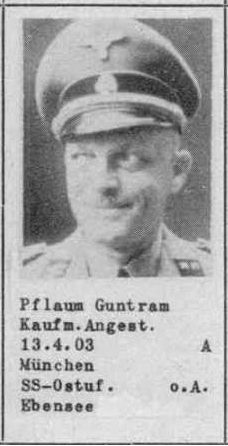 |
当初、商業事務員だったグラントラム・プフラウム(Guntram Pflaum,
1903-1945)は、1922年から1924年までオー
ベルラント連邦に所属していた。1932年にNSDAP(会員番号1,200,703)およびSS(SS番号39,477)に入隊する。当初はミュンヘン
のI.SS-Standarteに所属していたが、1935年にスタッフリーダーとして「Reichsstelle für
Sippenforschung」に移籍した。また、1938年から親衛隊大将の個人参謀を務め、親衛隊一般では1939年4月に親衛隊参謀長に昇格し
た。 1938年1月1日にレーベンスボルンの長官に就任したプフラウムは、1940年春までその職を務めた。 後任のマックス・ゾルマン(Max Sollmann)がこの職を退いた背景には、彼が責任を負うことになった協会がもつ負債問題があった。そして、第二次世界大戦中に兵役に召集さ れ た。ハインリッヒ・ヒムラー親衛隊大将の命により、独ソ戦開始後の1941年晩夏に「ゾンダーコマンド・プフラウム」を結成した。このゾンダーコマンド は、 高等親衛隊・警察指導部(HSSPF)ロシア・センターを拠点に、ドイツ人の子供を追跡し、SSの児童施設やドイツの養父母に預ける任務を負っていた。ド イツ国防軍の撤退に伴い、父親がドイツ兵である子どもたちの疎開を引き受けたのが、フラウムだった。1943年8月初めから、HSSPFオストランドで レースと入植のリーダーを務めた。1942年にはすでに、他の資料では1943年5月に、彼は人種絶滅政策のためのRFSSの特別代表となっており、この 職務で強制収容所を巡回していた。 |
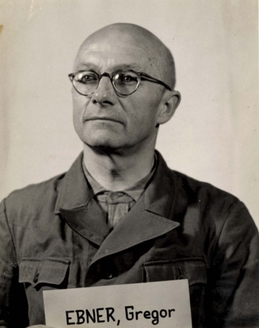 Gregor
Ebner (24 June 1892 – 22 March 1974[1]) was a medical doctor from
Kirchseeon near Munich. During the time of Nazi Germany he served as
the medical leader of all the Lebensborn Homes. Gregor
Ebner (24 June 1892 – 22 March 1974[1]) was a medical doctor from
Kirchseeon near Munich. During the time of Nazi Germany he served as
the medical leader of all the Lebensborn Homes.Ebner was born in Ichenhausen to Gregor Ebner, a coffee-house proprietor and his wife Marie (née Maurer). From 1914 to 1918 he took part in World War I as an Army Field Doctor. Thereafter he spent a few months with the Freikorps Epp. Following his graduation from medical school in June 1920 he opened a medical practice in Kirchseeon. In 1930 he became a member of the National Socialist German Workers' Party (NSDAP), commonly referred to in English as the Nazi Party (Membership number 340.925). He immediately became the Town Group Leader and Deputy Regional Leader. In 1931 he joined the General SS. Ebner met Heinrich Himmler in 1930 and was his house doctor for many years. In mid-1937 Ebner gave up his private practice and joined the Lebensborn Association full time. He remained in the function of medical head of all the Lebensborn run homes. In addition, he was the Chairman of the Disciplinary Court of the National Socialist Doctor's League 'from 1938. In 1939 he gained the rank of SS-Oberführer. On the 10 March 1948, Ebner was only found guilty of being a member of the SS at the Nuremberg SS Race and Settlement Main Office hearing and sentenced to time served Thereafter, he continued his medical practice in Kirchseeon and Wolfratshausen. 1)Lilienthal, Georg (2003). Der "Lebensborn e.V." Ein Instrument nationalsozialistischer Rassenpolitik. Frankfurt am Main: Fischer Taschenbuch Verlag. 2)Klee, Ernst (2007). Das Personenlexikon zum Dritten Reich (Revised 2nd ed.). Frankfurt am Main: Fischer. 3)Koop, Volker (2007). Der Führer ein Kind schenken: Die SS-Organisation Lebensborn e.V. Cologne: Böhlau Verlag. |
レーベンスボルンの運営に関して、ヒムラーに影響を与えた医師:グレ
ゴール・エーブナー(1892-1974) Gregor Ebner、1892年6月24日 - 1974年3月22日[1])は、ミュンヘン近郊のキルヒゼオン出身の医学者である。ナチスドイツの時代には、すべてのレーベンスボルン・ホーム(ミュン ヘン近郊のシュタインヘーリング?)の医療指導者として活躍した。 エブナーは、イヘンハウゼンでコーヒー店の経営者グレゴール・エブナーとその妻マリー(旧姓マウラー)の間に生まれた。1914年から1918年まで、陸 軍野戦医師として第一次世界大戦に参加した。その後、数ヵ月間、エップ自由軍に所属した。1920年6月に医学部を卒業した後、キルヒゼオンで診療所を開 業した。1930年、彼は国家社会主義ドイツ労働者党(NSDAP)、英語では一般にナチ党と呼ばれている党員になった(会員番号340.925)。彼は すぐに町のグループリーダー、副地域リーダーになった。1931年、彼はSS総隊に入隊した。エブナーは1930年にハインリッヒ・ヒムラーと出会い、長 年にわたって彼のハウスドクターを務めた。 1937年半ばにエブナーは開業医を辞め、レーベンスボルン協会に専任(医療顧問, 1936-?)で参加した。その後も、レーベンスボルンの運営する全施設の医局長として活躍した。さらに、彼は1938年から国家社会主義医師連盟の懲戒 裁判所長官を務めた。1939年にはSS親衛隊上級大将の地位を獲得した。 1948年3月10日、エブナーはニュルンベルク親衛隊人種収容所本部の審理で親衛隊員であることが認められ、服役を言い渡されただけだった。 |
●遺伝管理社会 : ナチスと近未来 / 米本昌平著、弘文堂 , 1989.3. - (叢書・死の文化 ; 4)
第1章 ナチス論のために(優生学的世界の現在;遺 伝子をめぐる状況;医学とナチズム;ナチズム=パラダイム論 ほか)
第2章 19世紀自然科学主義と民族衛生学の誕生 (社会ダーウィニズムとは何か;ヘッケルと一元論同盟;ドイツ優生思想の父アルフレート・プレッツ;民族衛生学と社会生物学 ほか)
第3章 民族衛生学の制度化と20年代(20世紀初 頭の優生学研究;第1次世界大戦と優生学の社会的認知;ドイツ国立遺伝学研究所の設立;ヒトラーと民族衛生学者と;戦争混血児問題と外国人労働者問題 ほ か)
第4章 人種主義としての超医療管理国家(アメリカ の優生政策;プロイセン保健局の断種法草案;ナチスの遺伝病子孫予防法;ヒトラーの民族主義的世界観;ナチス人権学と血統証明;安楽死論の起源 ほか)
第5章 戦後精神と現代医療(連合国のナチズム解 釈;医療犯罪裁判 ほか)
++
文献
その他の情報
Copyleft,
CC, Mitzub'ixi Quq Chi'j, 1996-2099